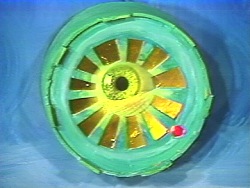Tony Oursler
Biography
Tony Oursler's brand of low-tech, expressionistic video theater is singular in contemporary art. Willfully primitive, often grotesque, and crafted with an ingenious visual shorthand, his psychodramatic landscapes of image and text are fabricated within the ironic vernacular of pop culture.
Oursler has worked in installation, painting, sculpture, and video since the mid-1970s. His recent mixed media installations, in which theatrical objects such as puppets and dolls are layered with video projections and spoken text, are prefigured in the wildly inventive body of videotapes that he has produced over the past twenty years.
In his single-channel video works, Oursler's idiosyncratic fictions take the form of bizarre narrative odysseys, horror-comedies that evoke Caligari by way of Eraserhead. Subjective visions of cultural and psychosexual delirium are pursued with outrageous black humor and a surreal theatricality.
The miniaturized, hand-constructed and painted mixed-media sets that are Oursler's signature suggest post-punk spectacles via German Expressionism; his somnambulant voiceovers and disorienting sound collages evoke stream-of-consciousness dreamstates. To enter one of his insular universes is to embark on a twisted journey that assumes the form and content of a hallucination of the contemporary collective unconscious. Strewn with the objects and idioms of adolescent fantasies, the detritus of mass cultural artifacts, and the macabre inversions of nightmares, Oursler's elaborate theatrical microcosms are populated by jerry-rigged props, hand-made puppets, found objects, body parts and, at times, human actors.
Fusing media-saturated artifice with primal obsessions, the iconography of his visual tableaux ranges from the biblical to the perverse; the language of his narrated texts is hilarious, irreverent and unexpectedly poetic. Utilizing low-tech gadgets to simulate and satirize video effects, his disjunctive fictions are haunted by themes of sexual alienation and hysteria, political and cultural violence, and the dichotomies of good and evil, life and death.
Early works, such as The Weak Bullet (1980) and Grand Mal (1981), have been described as "half Jackson Pollack, half David Cronenberg, and as funny as [they are] paranoid." The faux-naivete of his visual and spoken tales belies the textual sophistication of his meta-language of pop culture and subversion of narrative modes.
In the late 1980s Oursler increasingly used his narrative and visual strategies to construct social critiques. His more recent installation works continue to explore a kind of macabre psychodramatic theater with pop cultural elements. Fantastic Prayers, a 1999 CD-ROM project that translates many of these themes into an interactive format, is a collaboration of Oursler, writer Constance DeJong and composer/musician Stephen Vitiello.
Oursler's exploration of sound has led from stream-of-consciousness narration and voiceover of inanimate objects to collaborations with acclaimed musicians and sound artists. In the late 1970s and early 1980s, he experimented with sound and collaborated with Mike Kelley and John Miller as part of The Poetics, an "art band" that united the artists' interest in music and performance. The 1990 Tunic (Song for Karen), a music video made in collaboration with and starring Sonic Youth, merges Oursler's distinctive visual strategies with Sonic Youth's rock critique of the relation of celebrity, gender and body image. Works such as >Pop, a 1999 video portrait of musician Beck, Empty (2000), with David Bowie voicing text by Oursler, and Sound Digressions in Seven Colors, which features seven sound artists, are more recent collaborations with musicians. Oursler was born in 1957. He studied at Rockland Community College, Suffern, New York, and received a B.F.A. from the California Institute for the Arts, Valencia, where he studied under John Baldessari.
Oursler's videos and installations have been widely exhibited internationally, including one-person shows at Kunsthaus Bregenz, Austria; The Metropolitan Museum of Art, New York; Centre d'Art Contemporain, Geneva; Musée D'Orsay, Paris; Kunstverein, Hannover, Germany; The Museum of Modern Art, New York; Walker Art Center, Minneapolis; Los Angeles Contemporary Exhibitions (LACE); Jeu de Paume, Paris; Metro Pictures, New York; Lisson Gallery, London; Nyehaus, New York; Lehmann Maupin, New York; Museum Fur Gegenwartskunst, Basel; and the Museo D'Arte Contemporanea, Rome; among others. In 1999, a mid-career retrospective of Oursler's work was exhibited at Williams College, Williamstown, Massachusetts, and toured to The Contemporary Arts Museum, Houston and Los Angeles Museum of Contemporary Art. His work has also been seen in group shows at the Stedelijk Museum, Amsterdam; Hirshhorn Museum and Sculpture Garden, Washington, D.C.; Palais des Beaux-Arts, Brussels; Documentas IIX and X, Kassel, Germany; The Institute of Contemporary Art, Boston; Whitney Museum of American Art Biennial, New York; the Tate Gallery, London; and DuMont Kunsthalle, Cologne.
Oursler lives in New York.
